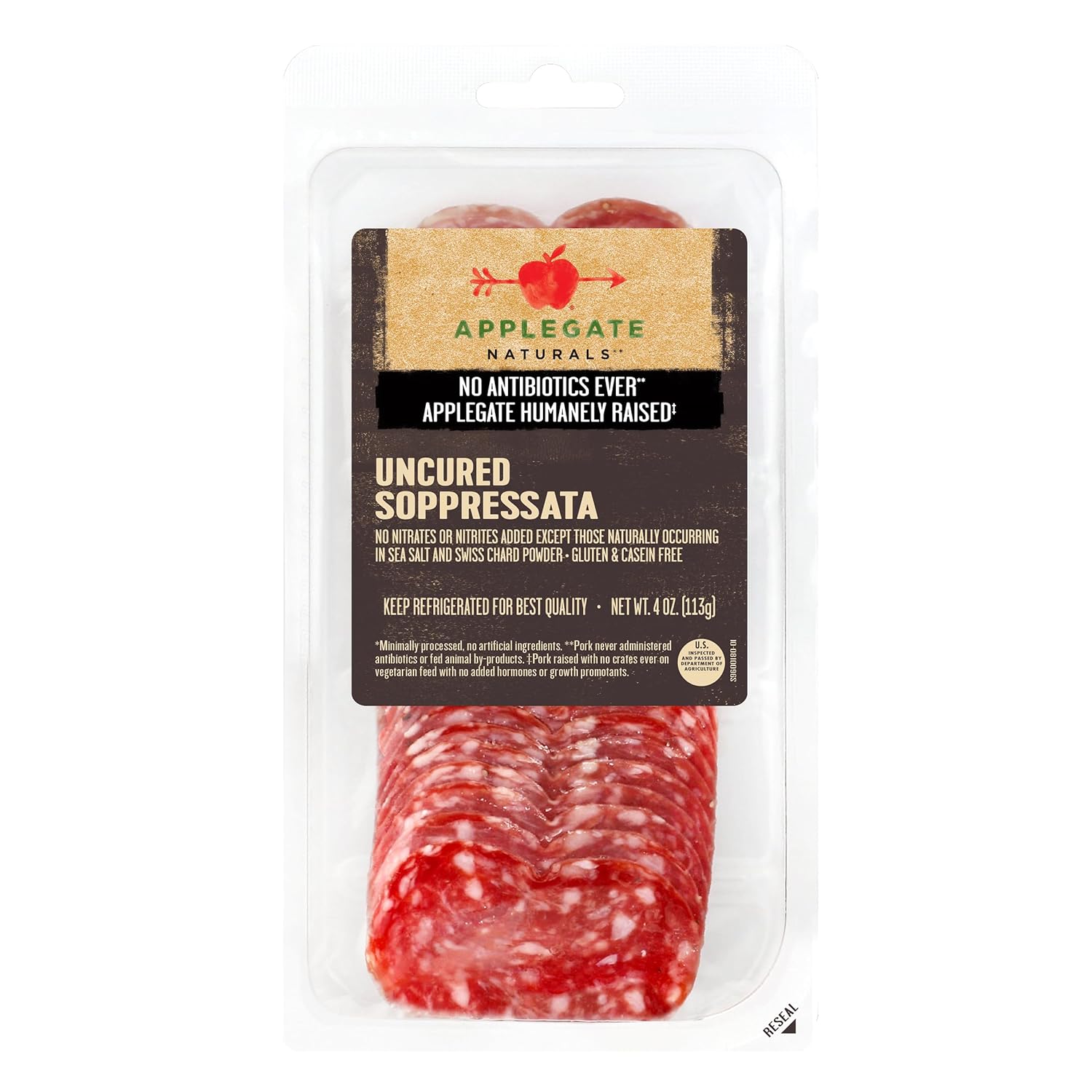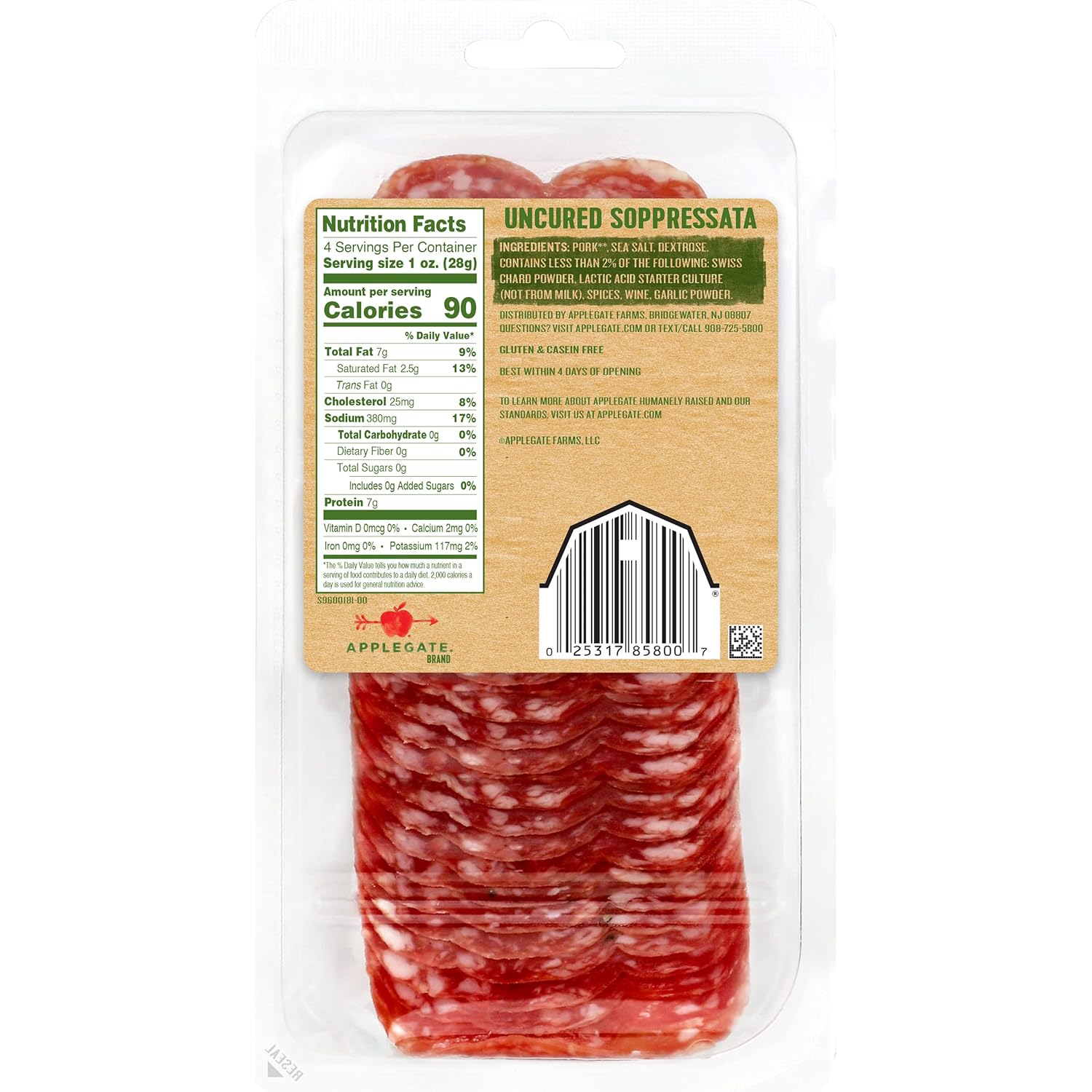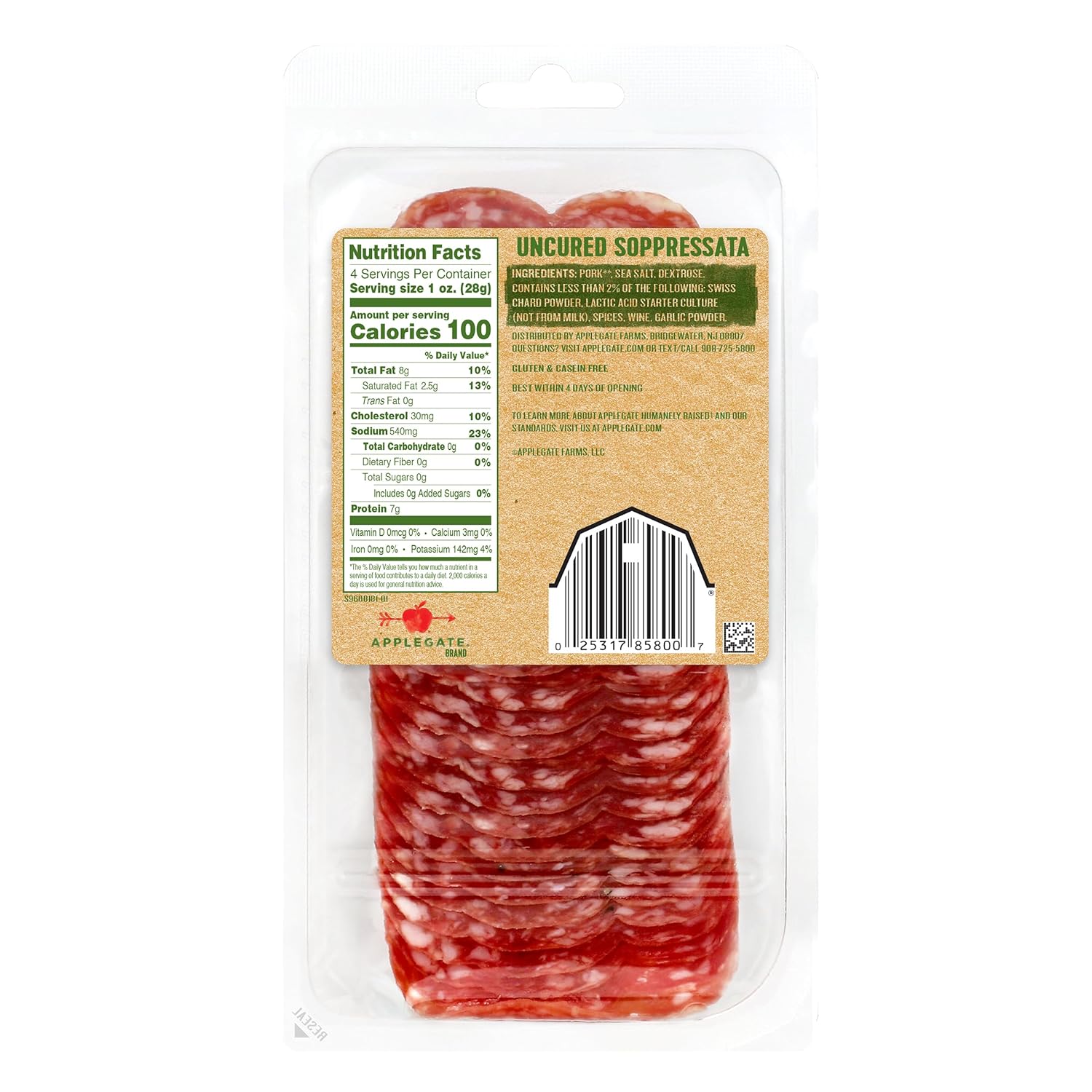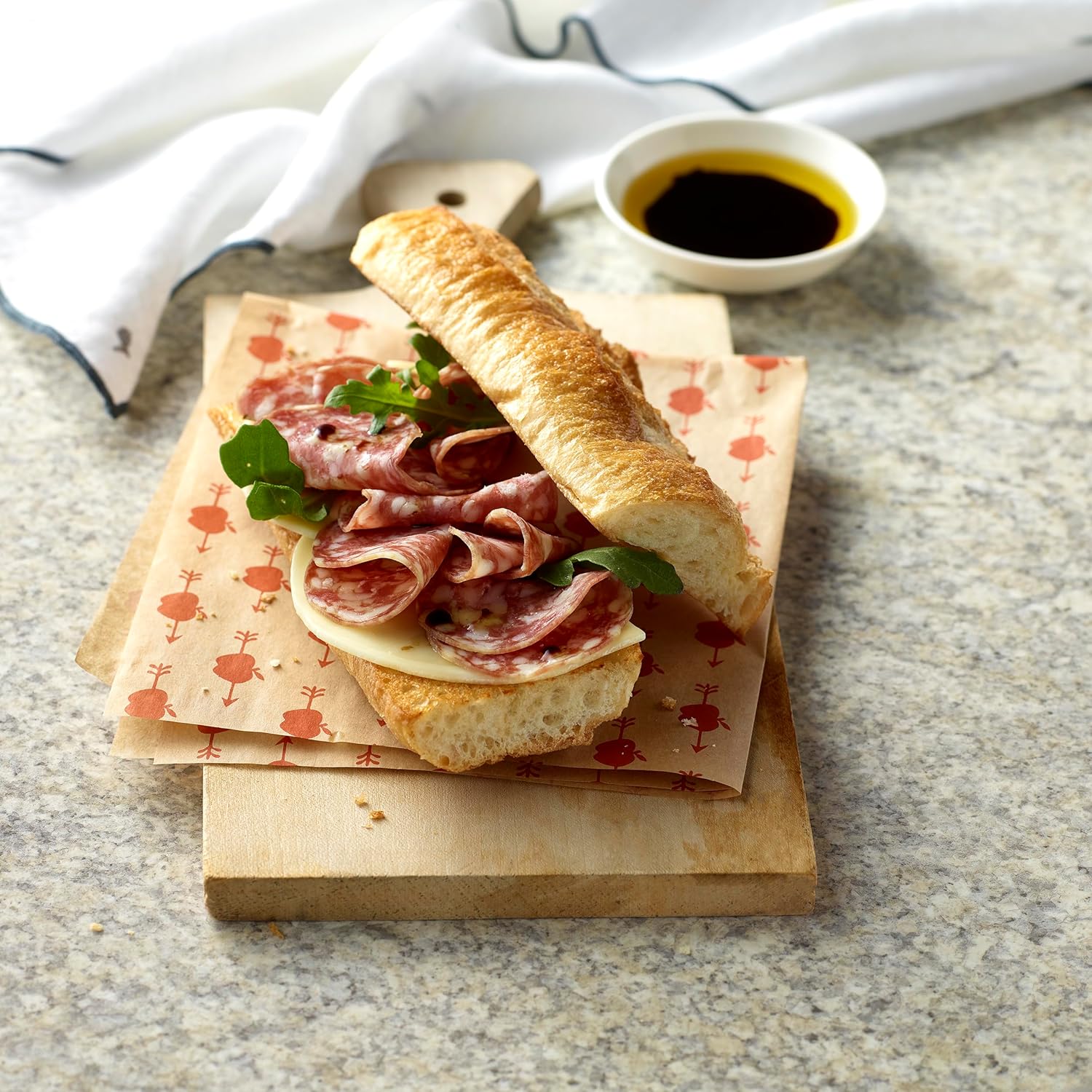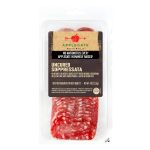
Applegate, Natural Uncured Soppressata, Review soppressata Buying Guide – Oemiu
Applegate Natural Uncured Soppressata: A Deep Dive and Comprehensive Buying Guide
Soppressata, a dry-cured Italian salami, is a culinary delight that elevates any charcuterie board, sandwich, or simple snack. The market offers a vast array of soppressata options, each with unique flavor profiles and production methods. In this article, we’ll delve into the specifics of Applegate Natural Uncured Soppressata, exploring its taste, ingredients, production, and how it stacks up against other soppressata varieties. Beyond the review, we’ll provide a comprehensive buying guide to help you choose the perfect soppressata for your needs, whether you’re seeking a spicy kick, a mild flavor, or a specific texture. Understanding the nuances of different types, like artisanal soppressata, will enhance your appreciation of this classic Italian delicacy.
Unpacking Applegate’s Offering: A Detailed Review
Applegate is a well-known brand committed to providing natural and organic meats, free from artificial ingredients and unnecessary additives. Their Natural Uncured Soppressata aligns perfectly with this philosophy. It’s crafted from humanely raised pork and boasts a relatively simple ingredient list, avoiding nitrates and nitrites typically found in cured meats. This “uncured” designation means that celery powder, naturally rich in nitrates, is used instead of synthetic curing agents. This appeals to consumers looking for cleaner label options, even if the end result is effectively the same in terms of preservation. The flavor profile is a blend of traditional Italian spices, offering a savory and slightly peppery taste without being overwhelmingly spicy. The texture is firm but not overly dry, making it pleasant to eat on its own or as part of a larger dish. While some artisan soppressatas boast bolder and more complex flavors, Applegate’s version offers a consistent and reliable taste that is accessible to a wide audience. The convenience of finding it in many grocery stores is another significant advantage.
The sourcing of the pork is a key consideration. Applegate emphasizes its commitment to humanely raised animals, which is a growing concern for many consumers. However, the specific details of their animal welfare standards may vary, so it’s worthwhile to investigate further if this is a top priority for you. The “natural” claim, while regulated, can still be somewhat ambiguous. In this case, it primarily refers to the absence of artificial ingredients and the use of natural curing agents. Ultimately, Applegate’s Natural Uncured Soppressata delivers a good balance of flavor, quality, and convenience, making it a solid choice for everyday consumption. It offers a taste of traditional Italian salami without the potentially harmful additives that some consumers are trying to avoid. Let’s consider how it compares to other pre-packaged cured meats on the market.
| Feature | Applegate Natural Uncured Soppressata | Generic Pre-Packaged Soppressata |
|---|---|---|
| Ingredients | Natural ingredients, celery powder for curing | May contain artificial nitrates/nitrites, artificial flavors |
| Pork Sourcing | Humanely raised pork | May not specify pork sourcing or welfare standards |
| Flavor | Savory, slightly peppery, consistent | Variable, may be overly salty or bland |
| Texture | Firm but not overly dry | Can be too dry or too soft |
| Availability | Widely available in grocery stores | Widely available |
| Price | Generally higher | Generally lower |
Navigating the World of Soppressata: A Buyer’s Guide
Choosing the right soppressata involves understanding the various factors that contribute to its flavor, texture, and overall quality. From the type of pork used to the spices incorporated and the curing process employed, each element plays a crucial role in the final product. This guide will provide you with the knowledge needed to make informed decisions and select a soppressata that perfectly suits your taste preferences and intended use. First, consider the origin. Different regions of Italy, and even different producers within those regions, will have distinct styles. For example, a Calabrian soppressata is known for its fiery heat, thanks to the generous addition of chili peppers. In contrast, a soppressata from Tuscany might be milder and more subtly flavored. Understanding these regional variations will help you narrow down your choices.
Next, pay attention to the ingredients list. A high-quality soppressata will typically have a relatively short and straightforward list, primarily consisting of pork, salt, spices, and a curing agent (either natural or synthetic). Avoid products with excessive amounts of artificial ingredients, fillers, or preservatives. The quality of the pork is also paramount. Look for soppressata made from heritage breeds or those raised with sustainable practices. This often translates to a richer and more flavorful product. The curing process is another critical factor. Traditional dry-curing methods, which can take weeks or even months, result in a more complex and nuanced flavor compared to faster, industrial processes. Finally, consider the intended use. A finely ground, mild soppressata might be ideal for sandwiches, while a coarsely ground, spicy variety could be better suited for a charcuterie board. Now, let’s break down the key considerations in more detail. Different types of soppressata offer different flavor profiles.
Key Considerations When Buying Soppressata:
- Origin: Understanding regional variations in flavor and spice levels is key.
- Ingredients: Look for a short, simple list with high-quality pork and natural spices.
- Curing Process: Traditional dry-curing methods typically yield a superior product.
- Texture: Choose a texture that suits your intended use, from finely ground to coarsely ground.
- Spice Level: Consider your tolerance for heat and opt for mild, medium, or spicy varieties.
- Intended Use: Select a soppressata that complements your chosen dish or snack.
- Price: Balance your budget with your desired quality and flavor profile.
Exploring the Spectrum of Soppressata: Types and Characteristics
The world of soppressata is incredibly diverse, offering a wide range of flavors, textures, and spice levels. From the fiery heat of Calabrian soppressata to the subtle sweetness of some Tuscan varieties, there’s a soppressata to suit every palate. Understanding these different types will allow you to appreciate the nuances of each and choose the perfect one for your needs. Calabrian soppressata, as mentioned earlier, is renowned for its intense heat. It’s typically made with generous amounts of chili peppers, both dried and fresh, giving it a vibrant red color and a fiery kick. This type of soppressata is often coarsely ground and has a slightly rustic texture. It’s a great choice for adding a bold flavor to pizzas, pasta dishes, or antipasto platters. In contrast, a soppressata from the Abruzzo region of Italy might be milder and more subtly flavored. It often incorporates spices like fennel, black pepper, and garlic, creating a more balanced and aromatic profile. This type of soppressata is typically finely ground and has a smoother texture, making it ideal for sandwiches or snacking.
Another important distinction lies in the cut of pork used. Some soppressatas are made entirely from lean pork, while others incorporate a higher proportion of fat. The fat content significantly impacts the texture and flavor of the final product. A soppressata with a higher fat content will be more tender and melt-in-your-mouth, while a leaner soppressata will be firmer and drier. The curing process also plays a crucial role in determining the characteristics of the soppressata. Traditionally, soppressata is dry-cured for several weeks or even months, allowing the flavors to develop and intensify. This slow curing process results in a more complex and nuanced flavor compared to faster, industrial methods. Experimenting with different types of soppressata is the best way to discover your personal preferences. Don’t be afraid to try new varieties and explore the diverse flavors that this Italian delicacy has to offer. And don’t forget to explore options like imported soppressata.
| Type of Soppressata | Origin | Spice Level | Texture | Typical Spices | Uses |
|---|---|---|---|---|---|
| Calabrian | Calabria, Italy | Spicy (High) | Coarsely Ground | Chili Peppers, Paprika | Pizza, Pasta, Charcuterie |
| Tuscan | Tuscany, Italy | Mild (Low) | Finely Ground | Fennel, Black Pepper, Garlic | Sandwiches, Snacks |
| Abruzzese | Abruzzo, Italy | Medium | Finely Ground | Black Pepper, Garlic, Rosemary | Charcuterie, Antipasto |
| Venetian | Veneto, Italy | Mild to Medium | Coarsely Ground | Cinnamon, Cloves, Garlic | Charcuterie Boards, Crostini |
Serving and Storage: Maximizing Your Soppressata Experience
Proper serving and storage are crucial for maximizing the flavor and longevity of your soppressata. How you present and care for your soppressata can significantly impact the overall experience. Serving soppressata at room temperature allows the flavors to fully develop. Remove it from the refrigerator at least 30 minutes before serving. This will soften the fat and release the aromatic compounds, enhancing the taste and texture. When serving on a charcuterie board, consider pairing it with complementary flavors and textures. Cheeses, olives, crackers, and fruits can all enhance the soppressata’s flavor profile. Experiment with different combinations to discover your favorite pairings. For example, a spicy Calabrian soppressata might pair well with a creamy provolone cheese and some crusty bread. A milder Tuscan soppressata could be complemented by fresh figs and a drizzle of balsamic glaze.
Proper storage is essential for preserving the quality of your soppressata. Once opened, wrap it tightly in plastic wrap or beeswax wrap and store it in the refrigerator. Avoid storing it in an airtight container, as this can trap moisture and lead to mold growth. The ideal storage temperature is between 34°F and 40°F (1°C and 4°C). Properly stored soppressata can last for several weeks in the refrigerator. However, it’s important to inspect it regularly for any signs of spoilage, such as mold growth or an off odor. If you notice any of these signs, discard the soppressata immediately. For long-term storage, soppressata can be frozen. Wrap it tightly in plastic wrap and then place it in a freezer bag. Frozen soppressata can last for several months without significant loss of quality. However, keep in mind that freezing can slightly alter the texture, making it slightly drier. Defrost frozen soppressata in the refrigerator overnight before serving. Remember that soppressata Milano has a slightly different flavor profile that may affect pairing choices.
Soppressata Beyond the Charcuterie Board: Creative Culinary Applications
While soppressata is a star on any charcuterie board, its culinary versatility extends far beyond. This flavorful salami can be incorporated into a wide range of dishes, adding depth and complexity to both simple and elaborate meals. Consider using soppressata to elevate your pizza game. Thinly sliced soppressata can be added as a topping, either on its own or in combination with other ingredients like mozzarella, mushrooms, and olives. The spicy kick of Calabrian soppressata is particularly well-suited for pizza, adding a delicious heat that complements the other flavors. Soppressata can also be used to enhance pasta dishes. Crumble it into sauces or sauté it with vegetables to add a savory and meaty element. A simple pasta dish with soppressata, garlic, and olive oil can be incredibly satisfying. You can also incorporate soppressata into frittatas or omelets. Dice it into small pieces and add it to the egg mixture along with cheese and vegetables. This creates a hearty and flavorful breakfast or brunch dish.
Another creative application is to use soppressata as a filling for stuffed peppers or mushrooms. Combine it with rice, cheese, and herbs, and then stuff the mixture into bell peppers or mushroom caps. Bake until the peppers are tender and the filling is heated through. Soppressata can also be used to make delicious sandwiches. Thinly sliced soppressata pairs well with a variety of cheeses, vegetables, and condiments. Try a soppressata sandwich with provolone, roasted red peppers, and pesto on ciabatta bread. Or, create a simple yet satisfying sandwich with soppressata, mozzarella, and tomato on a baguette. Don’t be afraid to experiment and explore different ways to incorporate soppressata into your cooking. Its bold flavor and versatile texture make it a welcome addition to many dishes. Even options like domestic soppressata can provide a nice flavor when added to new recipes.
Frequently Asked Questions
What exactly is soppressata?
Soppressata is a dry-cured Italian salami, traditionally made from pork, although sometimes beef is also used. It’s seasoned with a variety of spices, which can vary depending on the region and the producer. The mixture is then stuffed into a natural or artificial casing and hung to dry-cure for several weeks or even months. This curing process gives soppressata its characteristic firm texture and intense flavor. It’s a staple of Italian charcuterie boards and is also used in various dishes to add a savory and spicy kick. There are many different regional variations of soppressata, each with its unique flavor profile and spice blend. These variations often reflect the local culinary traditions and available ingredients of the region.
Is soppressata the same as pepperoni?
No, soppressata and pepperoni are not the same. While both are Italian dry-cured sausages, they differ in several key aspects. Pepperoni is typically made from a blend of pork and beef, while soppressata is traditionally made only from pork, although some variations may include beef. Pepperoni is also generally finer in texture and has a more uniform red color due to the addition of paprika and other spices. Soppressata, on the other hand, can vary in texture from finely ground to coarsely ground, and its color can range from pale pink to deep red depending on the spices used. Pepperoni is almost always spicy, while soppressata can range from mild to very spicy, depending on the type and the spices used.
How long does soppressata last?
Soppressata has a relatively long shelf life due to the curing process. Unopened, vacuum-sealed soppressata can typically last for several months in the refrigerator. Once opened, it’s best to wrap it tightly in plastic wrap or beeswax wrap and store it in the refrigerator. Properly stored, opened soppressata can last for several weeks. Look for signs of spoilage such as an off odor or a change in color or texture. If you notice any of these, it’s best to discard the soppressata. Freezing soppressata is also an option for longer-term storage. Wrap it tightly in plastic wrap and then place it in a freezer bag. Frozen soppressata can last for several months without significant loss of quality, although the texture might be slightly altered.
Can I eat the casing on soppressata?
Is the casing natural or artificial?
Whether or not you can eat the casing on soppressata depends on whether it’s a natural or artificial casing. Natural casings are typically made from animal intestines and are edible. They often have a more rustic and uneven appearance. Artificial casings, on the other hand, are made from cellulose or collagen and are generally not recommended for consumption. They can be tough and difficult to chew. To determine the type of casing, check the label or ask the butcher. If the label doesn’t specify, a good rule of thumb is that if the casing looks very uniform and smooth, it’s likely artificial. Some people prefer to remove the casing regardless of whether it’s natural or artificial, as it can sometimes be tough or have a slightly bitter taste. Ultimately, it’s a matter of personal preference.
Is soppressata gluten-free?
Generally, soppressata is considered gluten-free, but it’s crucial to check the ingredient list to be absolutely sure. Most traditional soppressata recipes don’t include any gluten-containing ingredients. However, some producers may add gluten-containing fillers or binders to their products, especially in commercially produced varieties. Always look for a “gluten-free” label or carefully examine the ingredient list for any potential sources of gluten, such as wheat, barley, or rye. If you’re unsure, it’s best to contact the manufacturer directly to inquire about their production practices and potential cross-contamination risks. Choosing reputable brands that prioritize natural ingredients can help minimize the risk of gluten exposure.
What cheeses pair well with soppressata?
Soppressata’s bold and savory flavor profile makes it a versatile pairing partner for a wide range of cheeses. Creamy and mild cheeses like provolone, mozzarella, and ricotta offer a pleasant contrast to the spicy and salty notes of soppressata. These cheeses help to balance the flavors and create a smooth and satisfying mouthfeel. Firmer cheeses like cheddar, Gruyère, and Parmesan also pair well, providing a sharper and more complex flavor dimension. The nutty and slightly tangy notes of these cheeses complement the soppressata’s savory character. For a truly decadent pairing, try soppressata with a pungent blue cheese like Gorgonzola or Roquefort. The strong and assertive flavors of these cheeses create a bold and unforgettable combination. Ultimately, the best cheese pairing depends on your personal preferences. Experiment with different cheeses to discover your favorite combinations.
Where can I buy Applegate Natural Uncured Soppressata?
Applegate Natural Uncured Soppressata is widely available in many grocery stores and supermarkets across the United States. Major retailers like Whole Foods Market, Trader Joe’s, Kroger, and Safeway typically carry Applegate products. You can also find it in smaller, independent grocery stores and specialty food shops. To find the nearest location that sells Applegate Natural Uncured Soppressata, you can use the store locator on the Applegate website. Simply enter your zip code to find a list of retailers in your area. Online retailers like Seller and Instacart also offer Applegate products, making it convenient to purchase from the comfort of your own home. Be sure to check for any available coupons or discounts before making your purchase.
